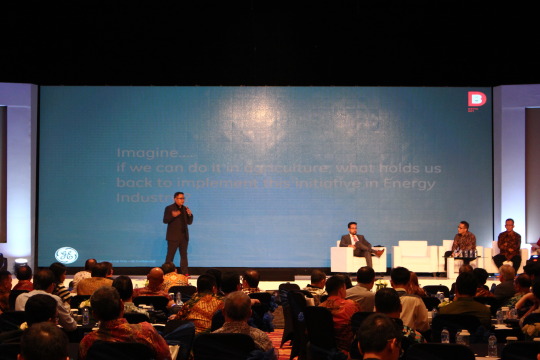Clik here to view.

More than 200 business executives, academics, and innovators based in the ASEAN region gathered in Jakarta, Indonesia for GE’s Future of Electricity Conference on 21 September 2016.
GE Reports ASEAN has produced a multi-part article series that highlights the key discussions of the conference, some covering breakthrough technologies that will make power generation and distribution more efficient, and accessible, and more importantly, potential solutions enabling Indonesia to accelerate development of its energy sector.
Today, we cover key takeaways from the conference.
Clik here to view.

Luis Sanchez Gonzales, Asia Pacific Digital General Manager, GE Power, on the need for the energy industry to rethink its overall approach:
“The industry is in transformation itself. We need to rethink the way we
electrify cities, rethink the way we produce, transmit and deliver the power.”
The reality is that till today, the energy landscape comprising power generation, grid management and power consumption is still fragmented. All areas typically operate within their own realms. The energy industry, as whole, requires more focus in collaborating, managing and analyzing intelligence to improve reliability, performance, sustainability, and efficiency.
Clik here to view.

Regi Wahyu, Industrial Vertical Leader, CEO of Dattabot (a big data analytics agency), on the importance of data and analytics:
“When we talk about
raw data acquisition, it’s not about the statistics of the data, it’s not about
aggregated data, but it’s about how we can get the granular data.”
With close to 2TB of data generated every day, and only two percent being analyzed, substantial investment is required in this area to provide industries with faster, better access to data at a granular level in user-friendly categories.
He cited an example in the agricultural sector, where the analysis of big data produced impressive benefits in a trial project. In 2016, HARA, a field management company – in collaboration with Dattabot – ran an analysis project for a 900-hectare farm – the enhanced analysis enabled the farm to increase yield production levels by 80%, while reducing costs by 10%.
The information was gathered from five satellites tracking data related to weather conditions, rainfall, and solar radiation impacting the farm every day. From this, HARA and Dattabot produced recommendations on the optimal time to plant seeds, analyze the soil, make weather forecasts, and manage pests and diseases.
While farming and energy production are different industries, it is worthwhile to review the principles, and actions, applied in the trial, and possible outcomes, if implemented in the energy industry.
Pak Sriyono D. Siswoyo, Organizational Development Head of Division PLN, on the need for the Indonesian Government to increase investment in talent development in the energy sector
“The
total number of human resources/workers required to complete this project (the
35 GW plan) is around 650,000.”
President Widodo announced ambitious development goals for Indonesia when he came to power. Infrastructure-wise, his administration wants to produce an additional 35 GW of energy by 2019.
This, according to Perusahaan Listrik Negara (PLN), Indonesia’s sole electricity distributor, will require a staggering 650,000 new employees working in all key areas – energy development, operation, generation, transmission and distribution.
In terms of economic growth, President Widodo, has targeted a seven percent growth rate (year-on-year) by 2019. The push for the lucky number seven growth rate needs to be supported by three strategies:
- Improve Indonesia’s ability to attract large numbers of skilled workers– in The Global Talent Competitiveness Index (GTCI) 2015–16, an annual benchmarking study conducted by leading business school INSEAD, Indonesia is ranked 90th from the 109 countries surveyed.
- Increase productivity of the current workforce.
- Implement initiatives that enable workers to upskill through knowledge transfer programs.
Clik here to view.

Steve Bolze, SVP, GE President & CEO, GE Power, on the importance of public-private partnerships:
“Indonesia has this unique
opportunity to build a showcase energy mix for the world over the course of the
next 10 or 20 years.“Given that the opportunity in the energy industry is too big
to be covered by any one industry, public-private partnerships will play a
crucial role in this.”
Compared to other nations in the region, Indonesia’s electrification rate (approx 80%) is significantly lower and needs urgent attention. The implementation of the 35 GW plan should therefore, be built on effective and efficient private-public partnerships.
Transformation of the Indonesian energy landscape will require high levels of investment and commitment from all parties – a private-public partnership is an avenue that allows the government to allocate resources to other areas of development, while tapping private sector capital markets for other projects. It also supports more knowledge transfer between relevant players.
With Indonesia’s demand for energy expected to triple between 2010 and 2030, the country needs to continually develop new plans, and implement programs, to stay ahead.
Handry Satriago, CEO of General Electric Indonesia, on the drive to make the 35,000 MW plan a reality:
“We can have a dream but if we don’t start working on it,
it remains a dream.”
One of President Widodo’s earliest reform achievements – to make the 35 GW dream a reality – was the removal of fuel subsidies.
Approximately sixteen billion dollars, or two hundred trillion rupiah, was saved when the government “called time” on the previous fuel subsidy policy in early 2015. The subsidized fuel initiative was a decades-old policy implemented to reduce future risks after the global oil-price crisis in the early 1970s.
With new reserves, the Widodo administration is focused on building new infrastructure – especially energy producing projects. To support this, other reforms have also been implemented including new policies to attract new investors and energy partners. The new directives are designed to reduce complexities in processes related to pricing, negotiation, procurement and licensing in the energy sector.
The post Five takeaways that encapsulate GE’s Future of Electricity Conference appeared first on GE Reports.